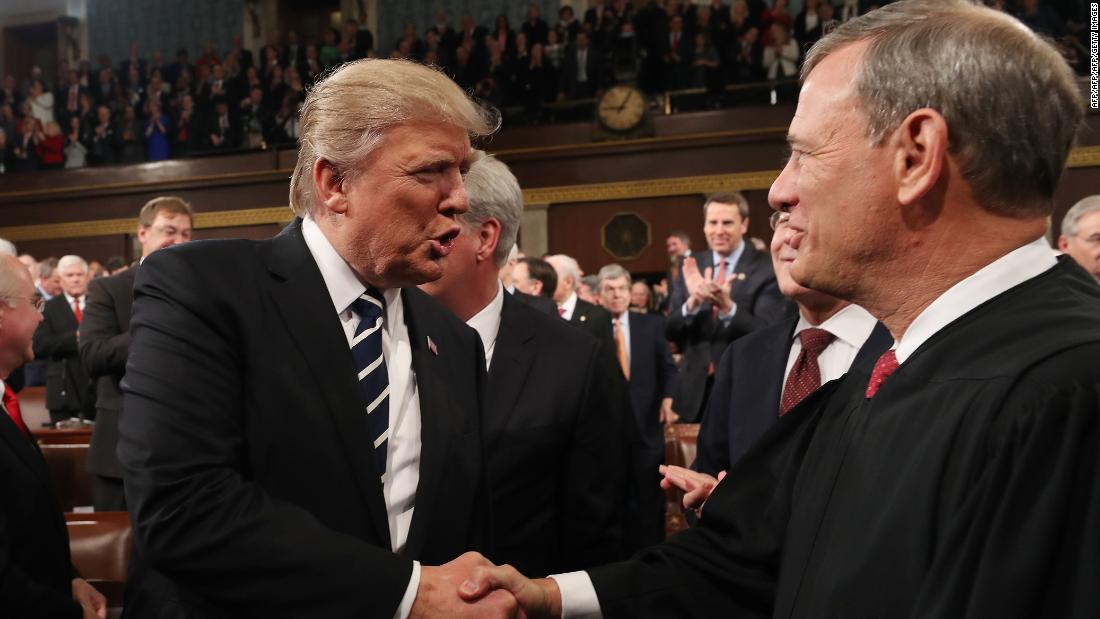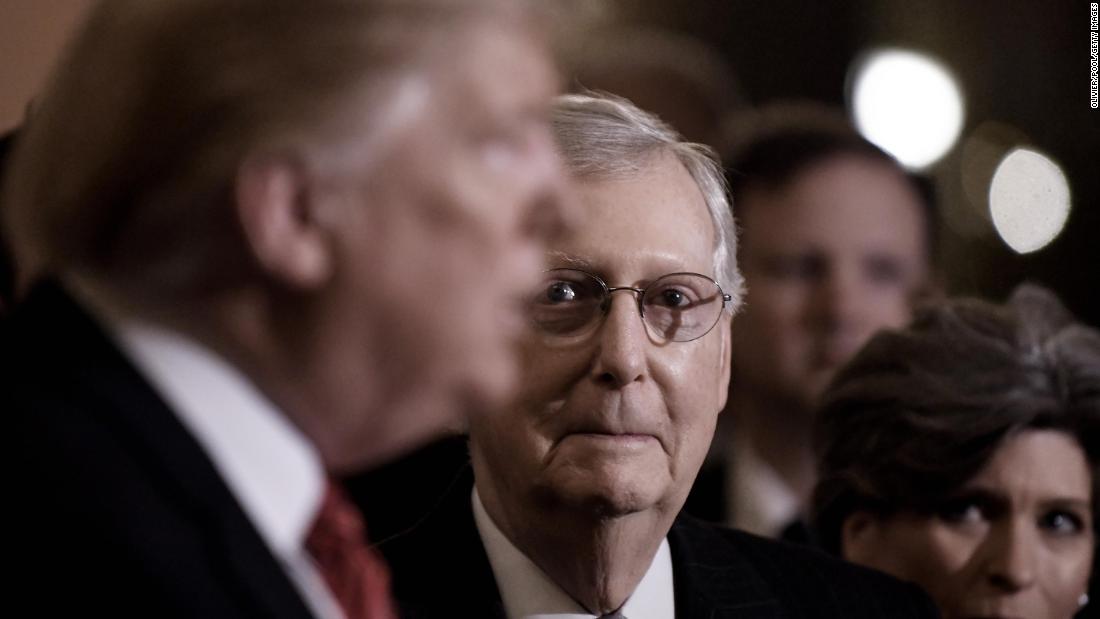How John Roberts might oversee a Senate impeachment trial

Washington (CNN)As the Democratic-led US House moves toward an impeachment vote on President Donald Trump, attention is turning to the likely Senate trial and how forcefully Chief Justice John Roberts might operate as he presides over the chamber.
Such questions already are being raised by legal and political observers, along with senators.
“I hope the chief justice would understand the need for the facts,” Senate Minority Leader Chuck Schumer said on CNN’s “New Day” Monday, adding his belief that Roberts would likely defer to the Senate majority on trial procedures.
Senators are quarreling over whether to call witnesses and which ones. Schumer has told Majority Leader Mitch McConnell that he wants at least four witnesses to testify, including Bolton and acting White House chief of staff Mick Mulvaney. Republican senators have suggested, alternatively, that they may want to call Hunter Biden, son of former Vice President Joe Biden.
Under the plain terms of the US Constitution and Senate rules, Roberts could wield a powerful gavel and rule on evidence and witnesses. Senate impeachment canon, dating to 1986, says the presiding officer “may rule on all questions of evidence.” The chief justice’s decision would stand unless overruled by a formal majority vote of the full Senate.
Roberts could, if he were so inclined, assume an outsized role in Trump’s fate.
But that would be a break from precedent and contradict Roberts’ own reserved manner. His predecessor in the role, Chief Justice William Rehnquist who oversaw the 1999 Bill Clinton impeachment trial, refused to assert great authority, saying in one episode he would claim authority only when “its exercise were clearly warranted.”
Roberts might also be disinclined to take an extensive role in the Senate realm when — as part of his primary function at the Supreme Court — he is already one of nine justices considering impeachment-related litigation, for example, on whether investigators may obtain Trump financial documents.
Roberts, 64, has had a fraught relationship with the 73-year-old Trump, now facing possible impeachment over his dealings on US security aid for Ukraine.
The men have been at odds publicly since 2012 when Trump, as a private businessman in New York, blasted Roberts on Twitter for voting to uphold the Obama-sponsored Affordable Care Act. Last year at this time, the two squared off as Trump derided a jurist who ruled against him in an asylum case as an “Obama judge.”
Roberts responded that America does not have “Obama” or “Trump” judges, but rather “dedicated judges doing their level best to do equal right to those appearing before them.”
He also has the court’s reputation to worry about.
In these polarized times, Roberts has tried to shield the court, as it decides cases, from the politics of the day. “
When you live in a politically polarized environment, people tend to see everything in those terms,” he said at a New York appearance earlier this year. “We will continue to decide cases according to the Constitution and laws without fear or favor.”
Rehnquist’s example
Roberts is likely to try to reinforce his own neutrality as he carries out his responsibility under the Constitution, which simply states that when the President is impeached, “the Chief Justice shall preside.”
That responsibility, unlike the chief’s duties across the street from the Capitol at the Supreme Court, is bound by Senate practice and not the legal rules of the regular court system. (In 1993 the Supreme Court declared that, under the Constitution, the House and Senate have the final say on how they run an impeachment and trial.)
Roberts, whose personal connection to Rehnquist dates to 1980 when he served as a law clerk, has often followed his mentor’s model, and is likely to try to avoid the spotlight during a Trump trial.
In 1999, Rehnquist adopted a largely ministerial posture as he sat on the dais above rows of wooden desks occupied by senators. He kept the arguments moving on schedule and handled objections that mainly tested procedures.
Rehnquist left questions related to witnesses, such as Monica Lewinsky, and motions, such as Democratic Sen. Robert Byrd’s to dismiss charges, to senators’ backroom negotiations. The House had impeached Clinton on allegations of perjury and obstruction of justice related to his efforts to conceal sexual liaisons with the former White House intern Lewinsky.
Senate Majority Leader Trent Lott, a Mississippi Republican, and Minority Leader Tom Daschle, a Democrat from South Dakota, worked out compromises — as much as possible — among the 100 lawmakers.
“It’s never easy to get 100 senators to agree on a method to proceed,” Lott said as the Senate was to begin hearing arguments on whether the charges should be dismissed, “so I think this was a good accomplishment.”
Throughout the five-week trial, senators set the rules for specific summons and motions, and then Rehnquist enforced them.
In one of the notable rulings beyond what was pre-arranged, Rehnquist prohibited the House managers, pressing the case for Clinton’s conviction, from calling senators “jurors.” Siding with a Democratic senator who had objected, Rehnquist declared: “The Senate is not simply a jury. It is a court in this case.”
On more consequential matters, Rehnquist could have asserted himself. A provision of the 1986 Senate rules dictates: “the Presiding Officer on the trial may rule on all questions of evidence including, but not limited to, questions of relevancy, materiality, and redundancy of evidence and incidental questions … .”
That would have forced senators to accept Rehnquist’s decision on a weighty matter, unless they voted to overrule him. But it never came to that.
A different challenge
This time might be different, some have speculated. In recent interview on CNN’s “State of the Union” with Jake Tapper, House Intelligence Committee Chairman Adam Schiff said the House Democrats might press at a Senate trial for testimony from White House officials who have so far refused to talk for the House inquiry.
Schiff said there was “merit to the idea that [they] may get a quicker ruling from a chief justice in a Senate trial,” should it come to that, than “going months and months litigating.” Schiff also speculated that Bolton and others might be compelled to testify in the Senate.
But Senate Republicans are indicating they want to keep things tight.
Sen. Joni Ernst signaled she is not interested in an impeachment trial with witnesses, telling reporters Monday: “The shorter the better.”
“This is a political exercise,” the Iowa Republican said. “Let’s just get it over with.”
Two decades ago in the Clinton trial, conflict arose between House managers and senators over how many witnesses would be called and whether they would be questioned in public. Senators agreed on three witnesses, none of whom appeared in public with the television cameras on.
Senators voted in public, 56-44, for the witnesses and by a similar 56-44 tally that rejected Byrd’s dismissal motion.
Rehnquist worked out of office space in the Capitol and brought legal briefs with him so he could keep up with the business of the court on breaks. Senate proceedings were regularly interrupted as leaders worked on the nuts and bolts.
When he was in the chair, Rehnquist consulted often with the Senate parliamentarian. Lott publicly laid out the ground rules and timing for each side — the House managers and Clinton’s lawyers. Lott then typically addressed Rehnquist and said, “I believe we’re ready to proceed, Mr. Chief Justice.” The chief recognized individual speakers and kept track of the time allotted.
In the end, senators were not able to reach the requisite two-thirds vote to convict, and on February 12, Clinton was acquitted on the charges of perjury and obstruction of justice.
A week before it was all over, Rehnquist wrote to former Oregon US Senator Mark Hatfield. “I have been introduced to the ways of the Senate in a big way. Since there have been no live witnesses, there has been very little for the presiding officer to do, but it is interesting to see the Senate at work.”
Other letters in Rehnquist’s archive at the Hoover Institution on the campus of Stanford University reinforce that attitude. He often joked, taking a page from Gilbert and Sullivan’s “Iolanthe,” that he “did nothing in particular, and did it very well.” A character in “Iolanthe” had also inspired the gold stripes that Rehnquist affixed to the sleeves of his black robe a few years earlier.
Roberts, who declined to comment for this story, is unlikely to engage in such levity or don anything but the standard black robe.
Read more: https://www.cnn.com/2019/12/02/politics/john-roberts-donald-trump-impeachment-trial/index.html




